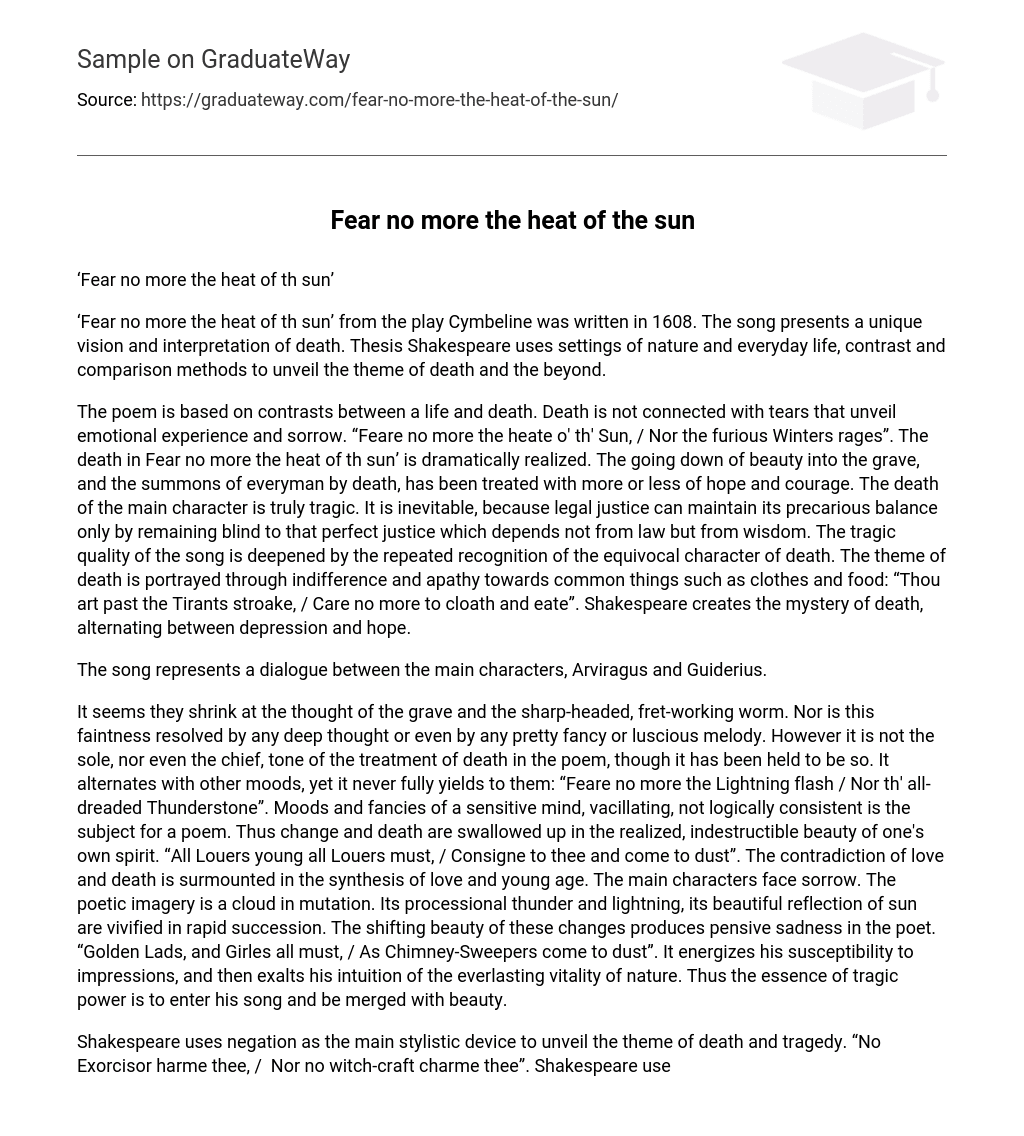‘Fear no more the heat of th sun’
‘Fear no more the heat of th sun’ from the play Cymbeline was written in 1608. The song presents a unique vision and interpretation of death. Thesis Shakespeare uses settings of nature and everyday life, contrast and comparison methods to unveil the theme of death and the beyond.
The poem is based on contrasts between a life and death. Death is not connected with tears that unveil emotional experience and sorrow. “Feare no more the heate o’ th’ Sun, / Nor the furious Winters rages”. The death in Fear no more the heat of th sun’ is dramatically realized. The going down of beauty into the grave, and the summons of everyman by death, has been treated with more or less of hope and courage. The death of the main character is truly tragic. It is inevitable, because legal justice can maintain its precarious balance only by remaining blind to that perfect justice which depends not from law but from wisdom. The tragic quality of the song is deepened by the repeated recognition of the equivocal character of death. The theme of death is portrayed through indifference and apathy towards common things such as clothes and food: “Thou art past the Tirants stroake, / Care no more to cloath and eate”. Shakespeare creates the mystery of death, alternating between depression and hope.
The song represents a dialogue between the main characters, Arviragus and Guiderius.
It seems they shrink at the thought of the grave and the sharp-headed, fret-working worm. Nor is this faintness resolved by any deep thought or even by any pretty fancy or luscious melody. However it is not the sole, nor even the chief, tone of the treatment of death in the poem, though it has been held to be so. It alternates with other moods, yet it never fully yields to them: “Feare no more the Lightning flash / Nor th’ all-dreaded Thunderstone”. Moods and fancies of a sensitive mind, vacillating, not logically consistent is the subject for a poem. Thus change and death are swallowed up in the realized, indestructible beauty of one’s own spirit. “All Louers young all Louers must, / Consigne to thee and come to dust”. The contradiction of love and death is surmounted in the synthesis of love and young age. The main characters face sorrow. The poetic imagery is a cloud in mutation. Its processional thunder and lightning, its beautiful reflection of sun are vivified in rapid succession. The shifting beauty of these changes produces pensive sadness in the poet. “Golden Lads, and Girles all must, / As Chimney-Sweepers come to dust”. It energizes his susceptibility to impressions, and then exalts his intuition of the everlasting vitality of nature. Thus the essence of tragic power is to enter his song and be merged with beauty.
Shakespeare uses negation as the main stylistic device to unveil the theme of death and tragedy. “No Exorcisor harme thee, / Nor no witch-craft charme thee”. Shakespeare use repetition to underlines the theme and inevitability of death: “As Chimney-Sweepers come to dust”, “All follow this and come to dust”, “Consigne to thee and come to dust”. This ‘confidence’ adds a fear and gloom of its own. The theme of death is remarked by a truly tragic expressiveness. His thought advances not so much through analysis and dissection, a scrupulous criticism, as by the natural, primitive, and poetic method of constantly reanimating old ideas with new experience, carrying the symbol further in expressiveness as experience itself developed.
The sadness and personal grief, which two main characters have spoken of, has been condensed and fused into a new emblem, a contrast between life and death. These emotional elements are ardently fused in a symbol of nature. Death is refined in repeatedly passing through the fiery crucible of human tragedy.
Works Cited
Shakespeare, W. `Fear no more the heat of the sun` 10 April 2007.
<ttp://www.poetryfoundation.org/archive/poem.html?id=176855>





